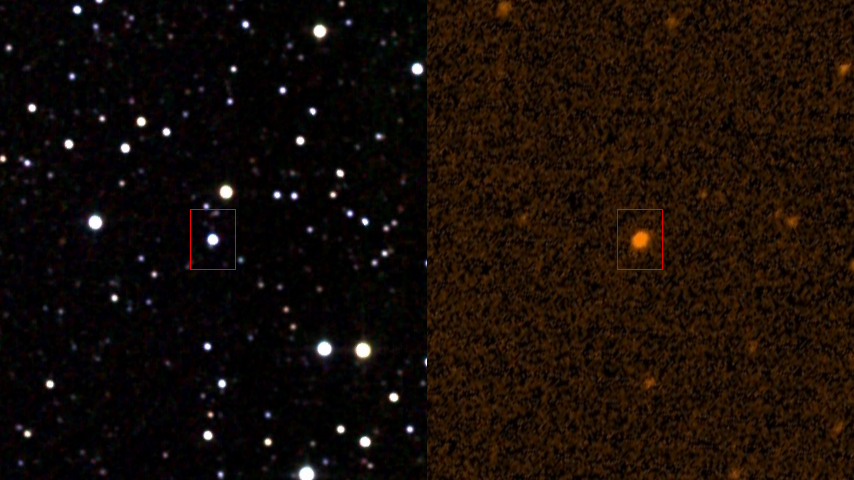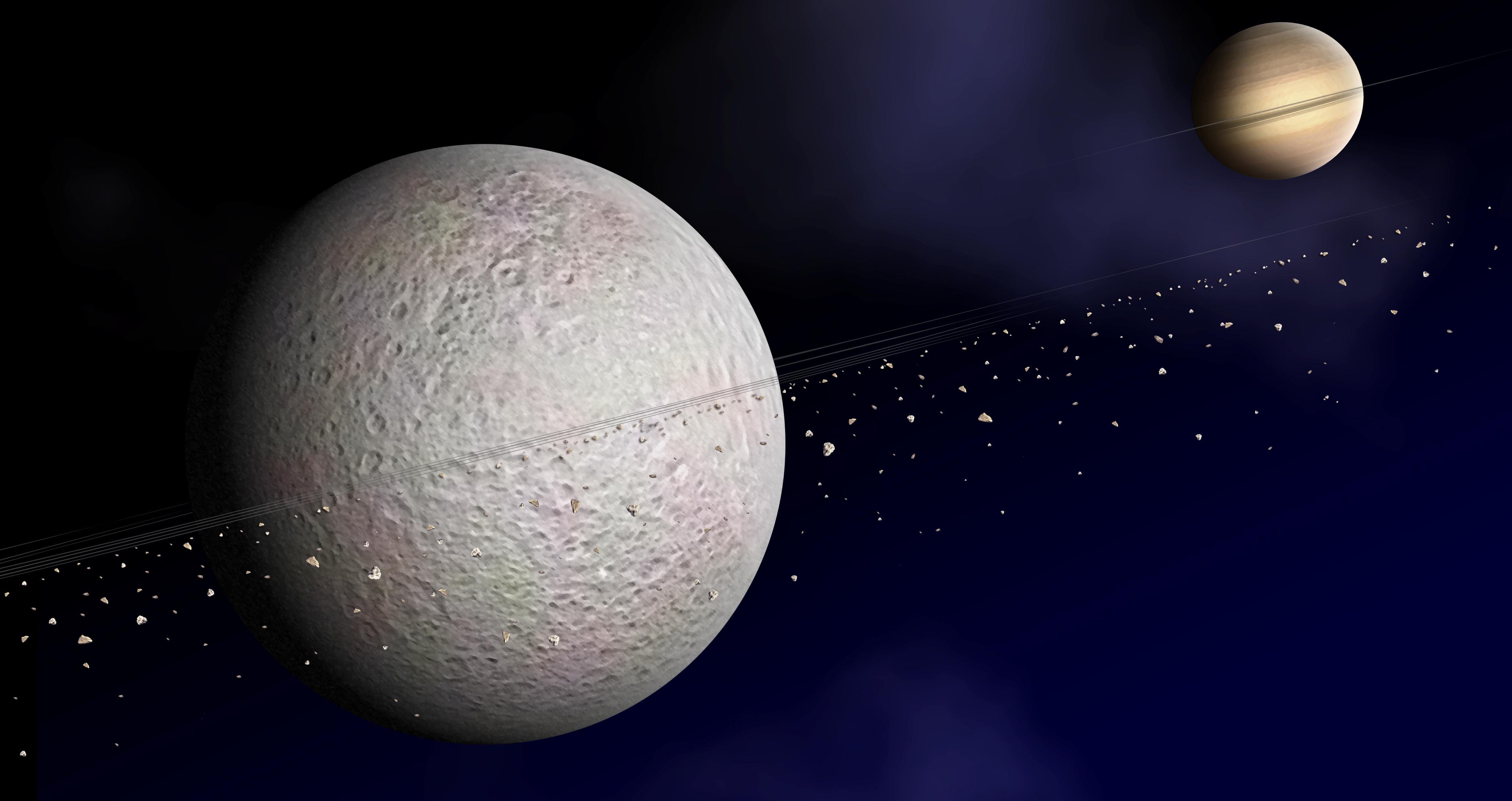|
Exomoons
Artist's impression of candidate exomoon Kepler-1625b I orbiting its planet. An exomoon or extrasolar moon is a natural satellite that orbits an exoplanet or other non-stellar extrasolar body. Exomoons are difficult to detect and confirm using current techniques, and to date there have been no confirmed exomoon detections. However, observations from missions such as Kepler have observed a number of candidates. Two potential exomoons that may orbit rogue planets have also been detected by microlensing. In September 2019, astronomers reported that the observed dimmings of Tabby's Star may have been produced by fragments resulting from the disruption of an orphaned exomoon. Some exomoons may be potential habitats for extraterrestrial life. Definition and designation Although traditional usage implies moons orbit a planet, the discovery of brown dwarfs with planet-sized satellites blurs the distinction between planets and moons, due to the low mass of brown dwarfs. This ... [...More Info...] [...Related Items...] OR: [Wikipedia] [Google] [Baidu] |
Natural Satellite Habitability
The habitability of natural satellites is the potential of moons to provide habitats for life, though it is not an indicator that they harbor it. Natural satellites are expected to outnumber planets by a large margin and the study of their habitability is therefore important to astrobiology and the search for extraterrestrial life. There are, nevertheless, significant environmental variables specific to moons. It is projected that parameters for surface habitats will be comparable to those of terrestrial planets like Earth and Mars, namely stellar properties, orbit, planetary mass, atmosphere and geology. Of the natural satellites in the Solar System's habitable zone – the Moon, two Martian satellites (though some estimates put those outside it) and numerous minor-planet moons – all lack the conditions for surface water. Unlike the Earth, all planetary mass moons of the Solar System are tidally locked and it is not yet known to what extent this and tidal forces influe ... [...More Info...] [...Related Items...] OR: [Wikipedia] [Google] [Baidu] |
Tidally Detached Exomoon
Tidally detached exomoons, also known as orphaned exomoons or ploonets, are hypothetical exoplanets that were formerly exomoons of another planet, before being ejected from their orbits around their parent planets by tidal forces during planetary migration, and becoming planets in their own right. As of , no tidally detached moons have yet been definitively detected, but they are believed to be likely to exist around other stars, and potentially detectable by photometric methods. Researchers at Columbia University have suggested that a disrupting detached exomoon may be causing the unusual fluctuations in brightness exhibited by Tabby's Star. History The term ''ploonet'', a blend of the words ''planet'' and ''moon'', was first used in a 2019 paper in the ''Monthly Notices of the Royal Astronomical Society ''Monthly Notices of the Royal Astronomical Society'' (MNRAS) is a peer-reviewed scientific journal in astronomy, astrophysics and related fields. It publishes original re ... [...More Info...] [...Related Items...] OR: [Wikipedia] [Google] [Baidu] |
Rogue Planet
A rogue planet, also termed a free-floating planet (FFP) or an isolated planetary-mass object (iPMO), is an interstellar object of planetary mass which is not gravitationally bound to any star or brown dwarf. Rogue planets may originate from planetary systems in which they are formed and later ejected, or they can also form on their own, outside a planetary system. The Milky Way alone may have billions to trillions of rogue planets, a range the upcoming Nancy Grace Roman Space Telescope is expected to refine. Some planetary-mass objects may have formed in a similar way to stars, and the International Astronomical Union has proposed that such objects be called sub-brown dwarfs. A possible example is Cha 110913−773444, which may either have been ejected and become a rogue planet or formed on its own to become a sub-brown dwarf. Terminology The two first discovery papers use the names isolated planetary-mass objects (iPMO) and free-floating planets (FFP). Most astronomical ... [...More Info...] [...Related Items...] OR: [Wikipedia] [Google] [Baidu] |
Kepler-1625
Kepler-1625 is a 14th-magnitude solar-mass star located in the constellation of Cygnus approximately away. Its mass is within 5% of that of the Sun, but its radius is approximately 70% larger reflecting its more evolved state. A candidate gas giant exoplanet was detected by the Kepler Mission around the star in 2015, which was later validated as a real planet to >99% confidence in 2016. In 2018, the Hunt for Exomoons with Kepler project reported evidence for a Neptune-sized exomoon around this planet, based on observations from NASA's Kepler mission and the Hubble Space Telescope. Subsequently, the evidence for and reality of this exomoon candidate has been subject to debate. Stellar characteristics Kepler-1625 is an approximately solar-mass star and yet is 1.7 times larger in diameter. Its effective temperature is around 5,550 K, slightly lower than that of the Sun. These parameters suggest that Kepler-1625 may be a yellow subgiant nearing the end of its life, with an a ... [...More Info...] [...Related Items...] OR: [Wikipedia] [Google] [Baidu] |
Tabby's Star
Tabby's Star (designated as KIC 8462852 in the Kepler Input Catalog and also known by the names Boyajian's Star and WTF (Where'sTheFlux?) Star, is a binary star in the constellation Cygnus approximately from Earth. The system is composed of an F-type main-sequence star and a red dwarf companion. Unusual light fluctuations of Tabby's Star, including up to a 22% dimming in brightness, were discovered by citizen scientists as part of the Planet Hunters project. The discovery was made from data collected by the Kepler space telescope, which observed changes in the brightness of distant stars to detect exoplanets. Several hypotheses have been proposed to explain the star's large irregular changes in brightness, but , none of them fully explain all aspects of the resulting light curve. It has been suggested that it is an alien megastructure, but evidence tends to discount this suggestion. In September 2019, astronomers reported that the observed dimmings of Tabby's Star ... [...More Info...] [...Related Items...] OR: [Wikipedia] [Google] [Baidu] |
Habitable Zone
In astronomy and astrobiology, the habitable zone (HZ), or more precisely the circumstellar habitable zone (CHZ), is the range of orbits around a star within which a planetary surface can support liquid water given sufficient atmospheric pressure.J. F. Kasting, D. P. Whitmire, R. T. Reynolds, Icarus 101, 108 (1993). The bounds of the HZ are based on Earth's position in the Solar System and the amount of radiant energy it receives from the Sun. Due to the importance of liquid water to Earth's biosphere, the nature of the HZ and the objects within it may be instrumental in determining the scope and distribution of planets capable of supporting Earth-like extraterrestrial life and extraterrestrial intelligence, intelligence. As such, it is considered by many to be a major factor of planetary habitability, and the most likely place to find extraterrestrial liquid water and biosignatures elsewhere in the universe. The habitable zone is also called the Goldilocks zone, a metaphor, all ... [...More Info...] [...Related Items...] OR: [Wikipedia] [Google] [Baidu] |
Kepler (spacecraft)
The Kepler space telescope is a defunct space telescope launched by NASA in 2009 to discover Earth-sized Exoplanet, planets orbiting other stars. Named after astronomer Johannes Kepler, the spacecraft was launched into an Earth-trailing heliocentric orbit. The principal investigator was William J. Borucki. After nine and a half years of operation, the telescope's reaction control system fuel was depleted, and NASA announced its retirement on October 30, 2018. Designed to survey a portion of Earth's region of the Milky Way to discover Terrestrial planet, Earth-size exoplanets in or near habitable zones and to estimate how many of the billions of stars in the Milky Way have such planets, Kepler's sole scientific instrument is a photometer that continually monitored the brightness of approximately 150,000 main sequence stars in a fixed field of view. These data were transmitted to Earth, then transit method, analyzed to detect periodic dimming caused by exoplanets that Astronomica ... [...More Info...] [...Related Items...] OR: [Wikipedia] [Google] [Baidu] |
Disrupted Planet
In astronomy, a disrupted planet is a planet or exoplanet or, perhaps on a somewhat smaller scale, a planetary-mass object, planetesimal, moon, exomoon or asteroid that has been disrupted or destroyed by a nearby or passing astronomical body or object such as a star. Necroplanetology is the related study of such a process. The result of such a disruption may be the production of excessive amounts of related gas, dust and debris, which may eventually surround the parent star in the form of a circumstellar disk or debris disk. As a consequence, the orbiting debris field may be an " uneven ring of dust", causing erratic light fluctuations in the apparent luminosity of the parent star, as may have been responsible for the oddly flickering light curves associated with the starlight observed from certain variable stars, such as that from Tabby's Star (KIC 8462852), RZ Piscium and WD 1145+017. Excessive amounts of infrared radiation may be detected from such stars, suggestive evid ... [...More Info...] [...Related Items...] OR: [Wikipedia] [Google] [Baidu] |
Submoon
A subsatellite, also known as a submoon or informally a moonmoon, is a "moon of a moon" or a hypothetical natural satellite that orbits the moon of a planet. It is inferred from the empirical study of natural satellites in the Solar System that subsatellites may be rare, albeit possible, elements of planetary systems. In the Solar System, the giant planets have large collections of natural satellites. The majority of detected exoplanets are giant planets; at least one, Kepler-1625b, may have a very large exomoon, named Kepler-1625b I, which could theoretically host a subsatellite. Nonetheless, aside from human-launched satellites in temporary lunar orbit, no subsatellite is known in the Solar System or beyond. In most cases, the tidal effects of the planet would make such a system unstable on an astronomical timescale. Terminology Terms used in scientific literature for subsatellites include "submoons" and "moon-moons". Colloquial terms that have been suggested include moonitos ... [...More Info...] [...Related Items...] OR: [Wikipedia] [Google] [Baidu] |
Kepler-1625b I
Kepler-1625b I is a possible moon of exoplanet Kepler-1625b, which may be the first exomoon ever discovered (pending confirmation), and was first indicated after preliminary observations by the Kepler Space Telescope. A more thorough observing campaign by the Hubble Space Telescope took place in October 2017, ultimately leading to a discovery paper published in ''Science Advances'' in early October 2018. Studies related to the discovery of this moon suggest that the host exoplanet is up to several Jupiter masses in size, and the moon is thought to be approximately the mass of Neptune. Like several moons in the Solar System, the large exomoon would theoretically be able to host its own moon, called a subsatellite, in a stable orbit, although no evidence for such a subsatellite has been found. Studies and observations The original paper presented two independent lines of evidence for the exomoon, a transit timing variation indicating a Neptune-mass moon, and a photometric dip ... [...More Info...] [...Related Items...] OR: [Wikipedia] [Google] [Baidu] |
Exoplanet
An exoplanet or extrasolar planet is a planet outside the Solar System. The first confirmed detection of an exoplanet was in 1992 around a pulsar, and the first detection around a main-sequence star was in 1995. A different planet, first detected in 1988, was confirmed in 2003. In 2016, it was recognized that the first possible evidence of an exoplanet had been noted in 1917. In collaboration with ground-based and other space-based observatories the James Webb Space Telescope (JWST) is expected to give more insight into exoplanet traits, such as their composition, environmental conditions, and potential for life. There are many methods of detecting exoplanets. Transit photometry and Doppler spectroscopy have found the most, but these methods suffer from a clear observational bias favoring the detection of planets near the star; thus, 85% of the exoplanets detected are inside the tidal locking zone. In several cases, multiple planets have been observed around a star ... [...More Info...] [...Related Items...] OR: [Wikipedia] [Google] [Baidu] |







